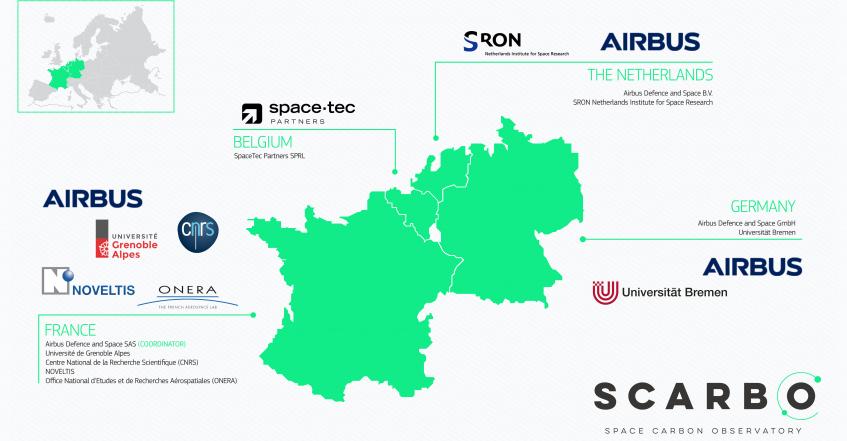
SCARBO scientists profile: Friedemann Reum, SRON
Many scientific minds from organisations across Europe have joined forces on project SCARBO. In this series of SCARBO scientists profiles, we’ll introduce you to the people behind our project – their scientific background as well as their role in SCARBO. Please meet Friedemann Reum from SRON Netherlands Institute for Space Research.

Please, tell us more about your background and your work.
My work is based on a model that allows me to infer greenhouse gas (GHG) emissions based on observations of the amount of GHG in the atmosphere. I apply this model to find out what useful things we can learn from SCARBO observations that would be conducted in the future, should the envisioned network be launched. In my day-to-day work, I spend a lot of time on three tasks: first, I need to think about how to set up my simulations of atmospheric GHG transport: for example, I need to make sure that the model simulates wind patterns realistically, and I need a realistic estimate of the uncertainties of SCARBO data. For the latter, I work with other groups in the SCARBO project. It also turned out that adjusting the model itself to my needs became quite a bit of model development and the second task in itself (see description in the poster below the article). Third, I need to collect and convert a number of datasets that the model needs as input, like existing estimates of GHG emissions.
Supercomputers are vital to my work. Compared to working on a “normal” home computer, the time saved is up to a factor 100 in my case. Without supercomputers, I simply couldn’t perform the calculations I make for my work. The key factors for me are both large memory (RAM) and a number of processors (i.e. the ability to use several computers in parallel for my computations). I use the Dutch national supercomputer “Cartesius”.
What role do measurements play for developing models? What kind of data do you use – satellites, sensors on the ground and/or on balloons?
My job is to infer greenhouse gas emissions based on atmospheric observations. These can be taken in many ways, but for the type of work I do, they are mostly obtained at ground-based sites where they are often analysed on-site in real-time, or from satellites. Other platforms are possible, but these are currently the platforms that enable most widespread data coverage, which is an import limitation of our work.
Other than that, weather forecast models, which rely on a dense global network of meteorological observations, are vital to my work. The same goes for models of greenhouse gas fluxes, which can make use of very different data streams and modelling approaches. I optimize them with the information in the atmospheric data.
Has the availability of such data changed (e.g. Sentinel-5P) changed your work?
A major limitation of my line of work is the coverage of atmospheric data – we simply don’t have enough data to answer certain urgent questions, such as GHG emissions on a national scale or from individual cities. The global coverage is much better now than it was 20 years ago, but for answering many important scientific questions, it’s still not enough. That’s why new data streams like from Tropomi on Sentinel-5P, or SCARBO, can make all the difference. I haven’t worked with Tropomi data personally, but its coverage and resolution enable analyses that weren’t possible before, like monitoring CH4 emissions of single facilities like natural gas wells from space.
Do you expect the results of SCARBO to change your work? Are there other ways you work related to SCARBO?
Addressing the abovementioned data shortage is the central goal of SCARBO, so it’s an important mission. I take part in the project because I want to work on exploiting such a vast dataset to quantify greenhouse gas emissions.
Tell us more about the technical models you presented at the Integrated Global Greenhouse Gas Information System event.
There are a number of models that can be used to estimate GHG emissions based on atmospheric data. For SCARBO, we want a model that can a) ingest a lot of atmospheric data (the foreseen SCARBO data volume is huge!), and b) simulate atmospheric GHG transport on high resolution. Not many models combine both abilities yet, so we decided to modify one to meet these needs. Long story short, I took a model that uses a global model to simulate atmospheric GHG transport and replaced this global model with one that can simulate transport on much higher resolution.
This poster is about a technical aspect of my work: I exchanged one component of the existing model that I use to infer GHG fluxes, the atmospheric transport (see the answer to the question below). The poster shows a successful test of the modified model, based on a simplified version of the setup that I use for addressing how well SCARBO can help us quantify GHG emissions.
(Download the poster below the article)
SCARBO importance for the world – in your opinion.
Although we know how important GHG’s are for the global climate, there are many unanswered questions about their sources and sinks. They determine how much of the GHG’s remains in the atmosphere and contributes to global warming, and that’s why we want to learn about these sources and sinks. SCARBO could help by adding much more data and thus help us to monitor GHG fluxes. This could aid in reducing human GHG emissions and understand future climate change.


